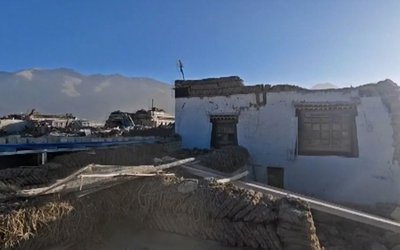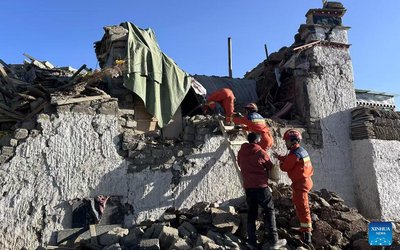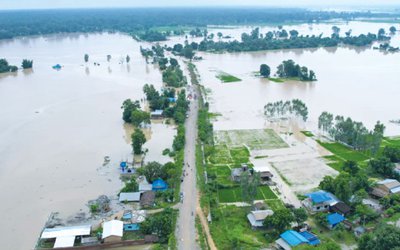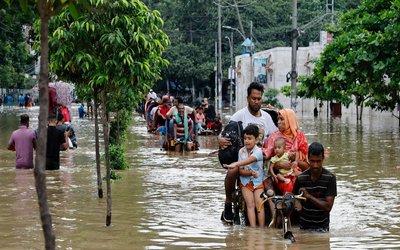
More than 6 million people have been impacted by the flooding across Nepal, India, and Bangladesh, and the flooding and resulting landslides have killed over 230 people and injured thousands.
While this storm system has started to dissipate, the region is still threatened by a monsoon season that runs through September.
Flood-related disasters often precipitate a host of health issues, including water- and vector-borne diseases. Cholera and typhoid can arise if sanitation and water delivery systems are damaged or destroyed, and mosquitoes can multiply in standing water, leading to a proliferation of malaria and dengue.
In Nepal, flood waters reached 30 of the nation’s 77 districts, including the capital, Kathmandu. While the monsoon rains were still falling, Dhulikhel Hospital in Kathmandu dispatched an emergency response team to southern Nepal. In support of their relief efforts Direct Relief built an 11-pallet donation of specifically requested flood relief supplies that shipped Friday.
Further south, the state of Assam in India has seen 4.3 million people affected by the floods, forcing over 85,000 to escape into densely packed displacement camps. In the last 12 months, Direct Relief has responded to two major disasters in India, the widespread flooding in Kerala and Cyclone Fani in northeastern India. Direct Relief was a major medical response actor during the floods in Kerala, dispatching 12 tons of medical aid to Amrita Institute of Medical Sciences and Meenakshi Mission Hospital.
In Bangladesh, where recent storms killed 29 people, remains especially vulnerable during monsoon and cyclone season due to the Rohingya refugees who fled violence in Myanmar and now reside in camps in the flood-prone coastal district of Cox’s Bazar.
Nepal’ State
Incessant rainfall since 11 July afternoon there has killed 29 people and displaced 2,065 households in Central and Eastern part of the country. Recorded highest rainfall for 24 hrs (11-12 July) was 311.9 mm at Simara, Bara, and 245 mm was recorded in Janakpur. The communications systems are semi-functioning in the worst affected areas.
The most affected districts are Sarlahi, Mahottari and Rautahat...While the weather situation is improving in the Kathmandu valley, the authorities have issued warning alerts to residents along the Kankai, Koshi, Tamor, Bagmati, Kamala, East Rapti watersheds in Provinces 1, 2 and 3. (Office of the UN Resident Coordinator, 13 Jul 2019)
Incessant rainfall since 11 July afternoon has killed 64 people and temporarily displaced 16,520 households to date (approximately 80,000 people) in Central and Eastern Nepal. While there are humanitarian needs, this is a localized situation, smaller in scale than 2017 when around 460,000 were temporarily displaced...The communications systems and electricity are semi-functioning in the worst affected areas (Sarlahi, Mahottari, Saptari and Rautahat).
While the weather situation is improving, and the flood water levels are receding, the authorities have issued warning alerts to people in Provinces 5, 6 and 7 as heavy rain is expected in those areasin the coming days. (Office of the UN Resident Coordinator, 15 Jul 2019)
Relief efforts are ongoing, and the situation is progressively returning to normal. The temporarily displaced population is gradually returning: According to the Ministry of Home Affairs, the number of temporarily displaced has decreased to 11,839 households from a peak of 17, 431 on 16 July. Flood waters have receded in most areas, and following repair works major highways are operational. However, rural roads in some area of the southern parts of Terai districts remain inaccessible, and water logging and associated damages in some locations in the southern part of Saptari, Rautahat and Mahottari continue to pose operational challenges.
The axis of this monsoon trough has moved south, away from the Terai region of Nepal. Thus, the monsoon rainfall is less active across the country overall, although the authorities have asked Provinces 5, 6 and 7 to be on standby and issued alerts to major watersheds in those areas, according to the forecast. (Office of the UN Resident Coordinator, 18 Jul 2019)
According to the National Emergency Operation Centre (NEOCO) as of 19 July, 90 people died, 29 are still missing and 41 have been reported injured as a result of ongoing heavy Monsoon rains. The Nepal Ministry of Home Affairs (MoHA) and Nepal Survey Department report that 11,839 are displaced. In the last 7 days, 92 landslides and 83 floods have affected the country. (ECHO, 19 Jul 2019).
Source: Reliefweb
- Korean Embassy Hosts FRIENDS OF KOREA 2025 Event in Kathmandu
- Apr 19, 2025
- Weather Forecast: Partly To Generally Cloudy With Rain And Thunder Acrosss Nepal
- Apr 19, 2025
- Minister Dahal Directed To Complete The Dannune Portion Of Road Before Monsoon
- Apr 18, 2025
- Kanchenjunga Diamond Festival Being Celebrated From Today To Mark The 70th Anniversary Of The First Successful Ascent
- Apr 18, 2025
- RPP To Hold Protest In Restricted Areas Of Kathmandu On April 20
- Apr 18, 2025















